
November 20, 2013
"Father Victor’s Washington:" An Article on the Life of our Priest
in the Capital
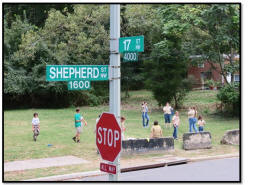 Russian
speech is heard on Shepherd Street (or "Pastor Street," if you
will), coming from the third generation of Russian scouts, who are
playing volleyball across the street from a church. Playing at some
distance from their teachers, this younger generation switched to
English from time to time. At the church, under a tent, is a group
of younger children, who repeated the words of "Our Father" uttered
by one of the girls. I stood at one side and marveled at the mosaic
shining in the sunlight, the tile-work of the church rising to the
sky… Then slowly, through the Indian-summer fog of sunny orange
bushes and rich colors, I ascended the steep staircase. St. John the
Baptist Cathedral in America’s capital was built in the
Muscovite-Yaroslavl style of the 17th century, like a carved
statuette sitting in the palm of one’s hand. There is only a handful
of such churches in Orthodox America. And parish churches dedicated
to the Beheading of Righteous John the Forerunner, they say, number
only some 25 throughout the Orthodox world.
Russian
speech is heard on Shepherd Street (or "Pastor Street," if you
will), coming from the third generation of Russian scouts, who are
playing volleyball across the street from a church. Playing at some
distance from their teachers, this younger generation switched to
English from time to time. At the church, under a tent, is a group
of younger children, who repeated the words of "Our Father" uttered
by one of the girls. I stood at one side and marveled at the mosaic
shining in the sunlight, the tile-work of the church rising to the
sky… Then slowly, through the Indian-summer fog of sunny orange
bushes and rich colors, I ascended the steep staircase. St. John the
Baptist Cathedral in America’s capital was built in the
Muscovite-Yaroslavl style of the 17th century, like a carved
statuette sitting in the palm of one’s hand. There is only a handful
of such churches in Orthodox America. And parish churches dedicated
to the Beheading of Righteous John the Forerunner, they say, number
only some 25 throughout the Orthodox world.
How is it that a church, devoted to such a sad event, came to be in
this intellectual, refined city of Washington?
The founding of this church was tied to an important event in the
life of the Russian Orthodox Church Outside of Russia and the
Russian Diaspora. In 1949, Archbishop John (Maximovitch) came to the
American capital from the distant island of Tubabao, with the aim of
interceding for his flock, which was forced to flee communist China
and found refuge on that small Pacific island. Five thousand
Russians were all that the Philippine government agreed to take in,
putting them on an island that was hit by typhoons every year. St.
John remained with his flock for three years, as the Russians lived
in jungle camps, serving in a tent chapel, walking about the entire
island in prayer every day. And over the entire period, not one
storm hit the island! In 1949, the holy man came to the American
capital to plead with U.S. senators to change their immigration
quota. As a result, legislation was passed which allowed these 5,000
Russians to come to America as permanent residents. While in
Washington, St. John founded the first parish of the Russian Church
Abroad in the city. He set down two conditions: that on that very
day they would perform an All-Night Vigil in his apartment and
Liturgy the next day, and dedicate the community to that day’s
feast: the Beheading of St. John the Forerunner.
This was the only parish founded by St. John of Shanghai in the
United States. Inside the church, on the left side of the ambo, is
an image of the saint, depicting the Capitol Building in which
Archbishop John pleaded on behalf of his flock, along with other
miraculous events connected to his life. In 1983, parish rector
Archpriest Victor Potapov, on a pilgrimage to the Holy Land, went to
St. George of Koziba Monastery in the Judean desert. The monastery
has a large part of the skull of St. John the Baptist. Learning
where the pilgrims were from, the abbot gave his blessing for a part
of the relic to be given to the parish, now one of 850 other relics
in the cathedral.
Fr. Victor has served at the cathedral for 37 years. In the Church
Abroad, most priests are forced to also hold "civil" jobs as they
minister to their flock, since most parishes cannot provide full
financial support to their priests. Fr. Victor took a job at Voice
of America radio station after he became convinced that St. John the
Baptist Cathedral needed a second priest. His family had made its
way to the American continent from the German camp of Manchenhof,
where Fr. Victor was born in 1948. His father, an officer in
Vlasov’s liberation army, had to change his name, so they became the
Potapovs.
"Papa and the other Vlasov soldiers were taken prisoner," said Fr.
Victor. "After the war they were repatriated to the Soviet Union.
The next day after the betrayal, they were going to execute him. But
that night he had a dream. A voice told him ‘Run, run!’ And so he
fled the transit camp. After 30 days of wandering through the
forests and towns of Germany, he made his way to a DP
[displaced-persons] camp, where he met my mother, whose family had
been deported to Germany as forced laborers, and they married.
Archpriest Mitrofan Znosko-Borovsky married them in the barracks
chapel; he was later to become a bishop of ROCOR.
"In 1951, we came to New York. My grandfather, searching for work,
headed to Cleveland, and soon brought the rest of the family there.
Papa became a builder, and built 3-4 houses a year, which supported
us. In fact, he also built our St Sergius Cathedral in Cleveland."
"I Was Forced to Go to Church Under Threat of the Rod"
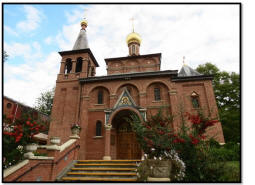 "I
grew up during the Cold War and very much wanted to assimilate to
the American way of life," continued Fr. Victor. "Americans did not
discern between Russians and Soviets. We tried to explain that
Russians were the first victims of the godless communist regime, but
all Russians were immediately deemed to be communists. This was very
unpleasant, and I tried to quickly ‘melt in the American pot.’
"I
grew up during the Cold War and very much wanted to assimilate to
the American way of life," continued Fr. Victor. "Americans did not
discern between Russians and Soviets. We tried to explain that
Russians were the first victims of the godless communist regime, but
all Russians were immediately deemed to be communists. This was very
unpleasant, and I tried to quickly ‘melt in the American pot.’
"I was forced to go to church under threat of the rod, because we
had to accompany my grandmother to church, which was in a bad
neighborhood. Once when I was 14, I went to church with my
grandmother; there were almost no other parishioners in church that
day. Fr. Michael Smirnov was serving, and in one instant, by Divine
mercy, it occurred to me that everything around me had profound
meaning. From then on I began to immerse myself in Orthodox
Christianity. Fr. Michael invited me to become an altar boy; he
taught me to read Church Slavonic. I was a rascal as an adolescent,
but thanks to Church reading, I was able to overcome this fault.
"In the 1960’s, I began to travel to the monastery in Jordanville.
They had a wonderful program then: the ‘summer boys.’ Participants
served as young novices; in the morning we would attend church,
serve in the altar, and whoever could would sing on the kliros. We
were taught the Law of God, we talked to the monks who had come
there from various monasteries of Russia and passed on wonderful
monastic traditions to us.
"After I graduated, I enrolled in Holy Trinity Seminary in
Jordanville, NY, and studied together with our present First
Hierarch, Metropolitan Hilarion, who was then just Igor Kapral. For
the first few months we lived in the same dorm room. The future
Vladyka was a good student, he loved to read the Lives of Saints,
and often read about how martyrs suffered aloud, with tears in his
eyes."
"I Met my Matushka at the Holy Sepulcher of the Lord"
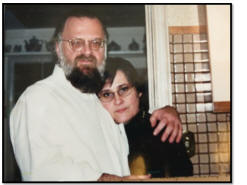 "It
was the summer of 1970. I went to Jerusalem with a group of pilgrims
headed by Bishop Laurus, the future metropolitan, and before that I
had gone to Mt. Athos and even considered taking the monastic path.
In Jerusalem, one pilgrim who was dismayed at my thoughts of
monasticism said that she noticed a perfect girl for me, Masha
Tchertkoff from Paris, the daughter of Archpriest Sergei Tchertkoff,
who served as a protodeacon under Bishop John (Maximovitch) for ten
years, when he was the Archbishop of Brussels & Western Europe.
Masha was on a pilgrimage of Russian Orthodox youth from Paris.
"It
was the summer of 1970. I went to Jerusalem with a group of pilgrims
headed by Bishop Laurus, the future metropolitan, and before that I
had gone to Mt. Athos and even considered taking the monastic path.
In Jerusalem, one pilgrim who was dismayed at my thoughts of
monasticism said that she noticed a perfect girl for me, Masha
Tchertkoff from Paris, the daughter of Archpriest Sergei Tchertkoff,
who served as a protodeacon under Bishop John (Maximovitch) for ten
years, when he was the Archbishop of Brussels & Western Europe.
Masha was on a pilgrimage of Russian Orthodox youth from Paris.
"I did not really want to introduce myself, but out of propriety,
not wishing to disappoint her, I did. I spoke no French, Masha did
not speak English well, so we spoke Russian. Four days later, she
left for France, and I returned to America. We began to write, and
one year later, at the end of August 1971, we were married in
Cleveland. Her father, Fr. Sergei, performed the ceremony with her
uncle, Fr. Vladimir Rodzianko, future Bishop Vasily of the Orthodox
Church in America. On January 1, Metropolitan Philaret (Voznesensky)
ordained me to the diaconate, and sent me to the renowned Holy
Virgin Protection Church in Nyack, NY. The famous author of the Law
of God, Archpriest Seraphim Slobodskoy, had served at this parish
for many years. Serving in Nyack as a deacon was very rewarding. We
had a magnificent parish school, where I taught the Law of God and
eventually, with Elena Slobodskoy and Sophia Koulomzin, began the
20-year run of the Orthodox journal ‘Trezvon.’ Our first son,
Matthew, was born in Nyack; he only lived for seven days. We managed
to baptize him in time, and even gave him Holy Communion. Matthew,
through his short life and death, taught us young parents a great
deal about life, and this helped in our further ministry…
"Once we went with Archbishop Nikon (Rklitsky) to attend the feast
day celebrations of St. Panteleimon Church in Hartford, CT. On the
way, we drove by the town of Stratford. Vladyka said that they were
in need of a priest for the new Church of the Presentation of Christ
in the Temple. I told Vladyka that I was prepared to take on that
assignment. On September 1, 1974, Metropolitan Philaret ordained me
to the priesthood, and I was assigned to that parish. It was small,
and we lived on the church grounds. It provided good experience in
the priesthood, but the parish could not support me. I needed to
find other work, and I was able to find a job at Bedford
Publications in New York City."
"How I Helped Immigrants"
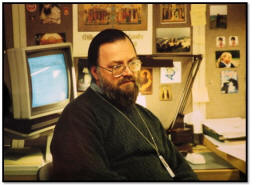 "The
publishing firm existed on government subsidies, printing and
distributing Russian-language literature which was banned in the
USSR: George Orwell’s 1984,
the works of Solzhenitsyn, samizdat manuscripts and political
literature, and found ways of delivering it to the Soviet Union. I
was hired to conduct interviews with recent immigrants. These were
the standard type: ‘What radio stations did you listen to, what kind
of literature interests you?’… I helped the newly arrived immigrants
find a place to live, rented moving vans, helped them in their daily
needs.
"The
publishing firm existed on government subsidies, printing and
distributing Russian-language literature which was banned in the
USSR: George Orwell’s 1984,
the works of Solzhenitsyn, samizdat manuscripts and political
literature, and found ways of delivering it to the Soviet Union. I
was hired to conduct interviews with recent immigrants. These were
the standard type: ‘What radio stations did you listen to, what kind
of literature interests you?’… I helped the newly arrived immigrants
find a place to live, rented moving vans, helped them in their daily
needs.
"During these interviews, it turned out that religion played an
important role in their lives. Many of them had listened to BBC
broadcasts of Metropolitan Anthony (Bloom), Fr. Vladimir Rodzianko
(later Bishop Vasily), Bishop John (Shakhovskoy), and Fr. Alexander
Schmemann; they desperately desired to own a Bible, and
philosophical and religious literature. Then I suggested to my
superiors that they send religious publications to the USSR. They
received the idea well, and I was charged with buying books and
sending packages. I would buy the works of Bulgakov, Frank,
Berdyaev, Solzhenitsyn, material published by Holy Trinity Monastery
in Jordanville, and found sailors, professors, and delegates who
came for ecumenical meetings, who enthusiastically took these
publications home.
"My commute from Connecticut to New York lasted for three years. It
would take three hours; on the way I would read, perfect my Russian,
and converse with interesting people. It was fascinating work, but
then a recession hit. My bosses decided that as a priest who
receives pay from my church, I could be laid off. But I could no
longer imagine my life separated from Russia, and began sending my
résumé to large firms which had any kinds of relationship with
Russia, offering my services as a translator or consultant."
"How St. John Helped Me"
 "It
was 1976," remembers Fr. Victor. "I knew that in a few months I will
be jobless. One evening my matushka and I were at home after Vigil,
and she asked me: ‘Do you regret becoming a priest?’ ‘Of course
not,’ I replied. ‘When I stand before the altar table and perform
the Bloodless Sacrifice, this gives me such strength, such joy, that
I am prepared to face anything.’ She was satisfied with that answer.
That night as I slept, Vladyka John of Shanghai appeared to me in a
dream. I had never known him personally, but revered him. And
although I am skeptical about the significance of dreams, I still
remember how that night Vladyka John talked to me for a long time,
and asked me the same question as my matushka: ‘Do you regret
becoming a priest?’ Again, I answered that I did not, at all.
Vladyka then answered that he also did not regret that I became a
priest, and discussed with me something about some important work to
be done relating to Russia. I don’t remember exactly what Vladyka
told me, but he planted within me a sense of confidence in the
future. I did not tell my matushka about this at the time. I found
myself in some sort of peaceful bliss, and I had to make sense of
what I experienced...
"It
was 1976," remembers Fr. Victor. "I knew that in a few months I will
be jobless. One evening my matushka and I were at home after Vigil,
and she asked me: ‘Do you regret becoming a priest?’ ‘Of course
not,’ I replied. ‘When I stand before the altar table and perform
the Bloodless Sacrifice, this gives me such strength, such joy, that
I am prepared to face anything.’ She was satisfied with that answer.
That night as I slept, Vladyka John of Shanghai appeared to me in a
dream. I had never known him personally, but revered him. And
although I am skeptical about the significance of dreams, I still
remember how that night Vladyka John talked to me for a long time,
and asked me the same question as my matushka: ‘Do you regret
becoming a priest?’ Again, I answered that I did not, at all.
Vladyka then answered that he also did not regret that I became a
priest, and discussed with me something about some important work to
be done relating to Russia. I don’t remember exactly what Vladyka
told me, but he planted within me a sense of confidence in the
future. I did not tell my matushka about this at the time. I found
myself in some sort of peaceful bliss, and I had to make sense of
what I experienced...
"I sent a letter to Voice of America radio station and offered my
services. A few days later, they invited me to New York for an
interview. I went, and soon Nikita Moravsky called me; he was one of
the people Vladyka John had rescued from Tubabao. He was the
director of the Soviet Program of Voice of America, the number-one
man there, having earlier worked as the cultural attaché at the
American Embassy in Moscow. When I began to work there, this
remarkable person was preparing to retire. He summoned me and said
‘You’re hired.’ Nikita Valerianovich and I then became close
friends; he joined our Committee for the Defense of Persecuted
Orthodox Christians, and became a parishioner of our cathedral. A
year or so ago, I performed his funeral…
"After Voice of America made me an offer of employment, I went to
see Metropolitan Philaret. He gave me his blessing to move to the
Washington parish, where the rector for 27 years had been the Greek
Archimandrite Nicholas (Pekatoros). Fr. Nicholas had an interesting
life. He was born in the end of the 19th century in Odessa to a
family of Greek Russians. He was ordained to the priesthood under
Patriarch Tikhon in 1922 and, until 1929, served under Holy
Hieromartyr Bishop Onuphry (Gagaliuk) in the Kherson-Odessa Diocese
in the Ukraine. In 1929, Fr. Nicholas left for Greece, where he was
soon tonsured a monk. He served in the Church of the Most Holy
Trinity in Athens, attached to the Russian Embassy in Greece. In
1952, he moved to the USA and, from 1953 to 1980, was the senior
priest of the Washington cathedral.
"After I was hired by VOA, the question arose about what to do with
the Stratford parish. I promised to the parishioners of Presentation
Church that I would not leave until a replacement was found, and so
every weekend I would travel from Washington, DC to Stratford to
serve Vigil and Liturgy."
To the U.S. Capital
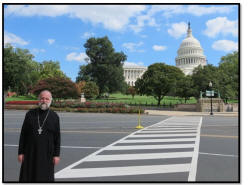 Four
and a half hours by car separate the U.S. capital from the ‘capital
of the world,’ New York City, but the cities and their inhabitants
are unbelievably different. Though Ilf and Petrov [early Soviet
humorists ‒ transl.] described Washington as "Single-Storied
America," both cities in my opinion are two different
"non-Americas."
Four
and a half hours by car separate the U.S. capital from the ‘capital
of the world,’ New York City, but the cities and their inhabitants
are unbelievably different. Though Ilf and Petrov [early Soviet
humorists ‒ transl.] described Washington as "Single-Storied
America," both cities in my opinion are two different
"non-Americas."
In October, the city is still in full bloom and there are no signs
of autumn. Only the Japanese cherry tree is not blossoming ‒ it is
the symbol of the National Cherry-Blossom Festival. That happens in
the springtime, when the whole city takes on a whitish-pink
coloration, and its residents and visitors are enchanted with the
Japanese blossoms.
Pierre-Charles L’Enfant, who laid out the plan for the city of
Washington, DC in the late 18th century, included diagonal avenues
which would be named for the states of the Union. These intersect
with streets which bear the names of generals, admirals, and famous
people, while others are numbered or named by letters of the
alphabet. Massachusetts Avenue was devoted to diplomats: this is
where most European embassies are located.
Washington, and especially its old town, Georgetown and Capitol
Hill, preserved the buildings of the 19th century. There are no
skyscrapers in the city: legislation prohibits any building rising
above the Capitol and the Washington Monument. Broad avenues,
severe, sharp-hewn and polished buildings also impart a sense of
grandeur and scale.
Geographically, the American capital is located within the state of
Maryland, but the Federal Government administratively separated the
city of Washington (not to be confused with Washington State on the
Pacific West Coast), into a separate unit ‒ the District of
Columbia. It forms its own capital, with its own budget, and
guaranteed municipal independence, which visitors can observe.
Without a penny in his pocket, a tourist can visit most of the
galleries and museums here, from the historic to the cosmic. You can
see the Capitol from almost all of them. But its proximity is an
illusion; one needs to reserve enough time after touring the museums
to reach the main legislative building in the nation: past the
monolithic government buildings, where Congressmen and Senators and
countless federal employees work… One does not sense under one’s
feet and under layers of asphalt the tunnels that provide access to
senators in bad weather (and to simply avoid emerging from their
office buildings) via train to the Capitol Building… You can walk
past the largest library in the world, the Library of Congress. Its
director, the scholar and admirer of Russia, James Billington,
received Sretensky Monastery Men’s Choir within its walls, and
presented the English-language translation of the book
Everyday Saints and its
author [Archimandrite Tikhon (Shevkunov) ‒ transl.]. Among the many
Russian exponents are the letters of Emperor Alexander II to Abraham
Lincoln, and the wonderful color photographic images of Russian
landscapes taken much later by Prokudin-Gorsky.
Fr. Victor and I made our way by car to the center of Washington,
DC. We immediately felt and succumbed to the beating of the
socio-political pulse of the American capital. Right before us, from
one of the official buildings toward another, streamed a column of
handicapped demonstrators: the wheelchair-bound, blind, lame,
accompanied by friends and assistance dogs, gradually, unhurriedly,
moving towards the legislative branch of the U.S. government. The
next day, the nation was to be hit by a government crisis, when a
conflict between the Democrats and Republicans sent federal workers
on an unplanned vacation. The free museums closed, disappointing
thousands of tourists.
"The headquarters of Voice of America is right next to the capital’s
museums, and my office windows looked out onto the Capitol
Building," explained Fr. Victor, pointing at a corner office on the
second floor of a building. "When I started working here in 1977, I
promised myself that every day during my lunch break I would visit a
museum and look at the exhibitions. But this was only a dream: all
my free time was devoted to parish matters."
"At First, I Was Only a Voice…"
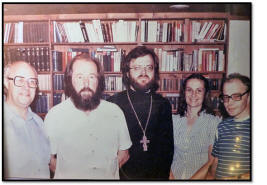 "I
was first hired by Voice of America as a translator of news. There
was a radio and TV program led by Vladimir Matlin, a Jewish man, who
broadcast under the name of Martin. Once during a meeting, Volodya
said, to his credit: ‘Why am I running this show if we have a
priest?’ So they gave me twenty minutes before the Jewish segment,
then we made an agreement with Volodya that we would divide the
broadcast in half. The question arose about how to present me, since
it was unprecedented for a priest to lead a VOA program. First I did
not identify myself. At first, I was only a voice. Debate continued
for a while. As we discussed how I should be introduced, I created a
special program called ‘The Meaning and Structure of Nativity
Services.’ This was a purely Orthodox Christian broadcast, with
singing and Gospel readings. Suddenly, from Cavendish, VT, where
Alexander Solzhenitsyn lived, the head of the Russian Department,
Victor Frantsuzov, got a phone call; it was from Natalia
Solzhenitsyn, who said that Alexander Isaevich was impressed by this
and other religious programming and wondered who was responsible for
them. Management was flattered, and cooler heads prevailed: Why be
coy about this, it’s a priest ‒ he is an authority! So, six months
after starting at VOA, I began to open my broadcasts with the words
‘Priest Victor Potapov at the microphone.’ We begin our weekly
broadcast of Voice of America’s Overview of Religious-Social Life.
Then as I signed off, Volodya Matlin would begin his segment. I was
later given more time, and I was given a new slot called ‘Religion
in Our Lives.’ We separated from the Jewish segment, and my portion
lasted 45 minutes and was aired five times a week. I also arranged
for a weekly broadcast of Liturgy from St. John the Baptist
Cathedral, with a sermon; meanwhile, on a daily basis, after the
political segment and news, an excerpt from Holy Scripture was read.
In the 1990’s, I began to record two weekly segments of ‘Religion in
Our Lives,’ which would air several times."
"I
was first hired by Voice of America as a translator of news. There
was a radio and TV program led by Vladimir Matlin, a Jewish man, who
broadcast under the name of Martin. Once during a meeting, Volodya
said, to his credit: ‘Why am I running this show if we have a
priest?’ So they gave me twenty minutes before the Jewish segment,
then we made an agreement with Volodya that we would divide the
broadcast in half. The question arose about how to present me, since
it was unprecedented for a priest to lead a VOA program. First I did
not identify myself. At first, I was only a voice. Debate continued
for a while. As we discussed how I should be introduced, I created a
special program called ‘The Meaning and Structure of Nativity
Services.’ This was a purely Orthodox Christian broadcast, with
singing and Gospel readings. Suddenly, from Cavendish, VT, where
Alexander Solzhenitsyn lived, the head of the Russian Department,
Victor Frantsuzov, got a phone call; it was from Natalia
Solzhenitsyn, who said that Alexander Isaevich was impressed by this
and other religious programming and wondered who was responsible for
them. Management was flattered, and cooler heads prevailed: Why be
coy about this, it’s a priest ‒ he is an authority! So, six months
after starting at VOA, I began to open my broadcasts with the words
‘Priest Victor Potapov at the microphone.’ We begin our weekly
broadcast of Voice of America’s Overview of Religious-Social Life.
Then as I signed off, Volodya Matlin would begin his segment. I was
later given more time, and I was given a new slot called ‘Religion
in Our Lives.’ We separated from the Jewish segment, and my portion
lasted 45 minutes and was aired five times a week. I also arranged
for a weekly broadcast of Liturgy from St. John the Baptist
Cathedral, with a sermon; meanwhile, on a daily basis, after the
political segment and news, an excerpt from Holy Scripture was read.
In the 1990’s, I began to record two weekly segments of ‘Religion in
Our Lives,’ which would air several times."
"The Mudslinger"
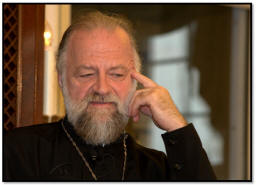 "Voice
of America’s broadcasts were often jammed. It was so painful; you
put in so much work, your heart and soul… In 1984, I was sent to
Russia for the first time. We had a program wherein all employees
who had never been to the country they reported on had to travel
there for 2-3 weeks, to get to know the situation, ‘breathe the
air’… By then I had already worked at the station for seven years, I
had name recognition, and I was given a diplomatic passport, for my
protection. Just before my trip to Moscow, the periodical ‘Trud’
published an article called ‘Mudslinger,’ in which Soviet citizens
were warned not to meet with me.
"Voice
of America’s broadcasts were often jammed. It was so painful; you
put in so much work, your heart and soul… In 1984, I was sent to
Russia for the first time. We had a program wherein all employees
who had never been to the country they reported on had to travel
there for 2-3 weeks, to get to know the situation, ‘breathe the
air’… By then I had already worked at the station for seven years, I
had name recognition, and I was given a diplomatic passport, for my
protection. Just before my trip to Moscow, the periodical ‘Trud’
published an article called ‘Mudslinger,’ in which Soviet citizens
were warned not to meet with me.
"I took a receiver with me, and after settling in to the Ukraina
Hotel, tried to tune in to my own broadcast, to see how it sounds
there. All I heard was a horrible noise! My friends consoled me,
saying that local Russians attach antennas, put the receivers on
window sills, on radiators; in a word, they made adjustments and
listened. Later, when Gorbachev declared the policies of glasnost
and perestroika, letters from all over Russia came pouring in. Many
of them were addressed to me personally. Some I answered on the air,
and I have kept all of them to this day for future scholars of
Russian-American relations in the late twentieth century.
"Our parish set up a fund called ‘Spiritual Literature for Russia,’
and Voice of America would cover the cost of sending packages to our
listeners. It was an exciting time!
"Thanks to VOA, I met many fascinating people. Three times I visited
Solzhenitsyn in Vermont, I spoke to his wife Natalia on the phone
all the time. The third time I visited Solzhenitsyn was with
Vladimir Soloukhin in 1985. This conspiratorial visit was
unforgettable, and deserves special attention. At that time I became
acquainted with the scholar Dmitry Likhachev and many other
remarkable individuals. Alexander Ginsburg, the human-rights
champion, lived in our house six years after being released from
prison camp.
"My arrival at VOA coincided with the appointment of the virtuoso
cellist Mstislav Rostropovich as the Musical Director of the
National Symphony Orchestra. One of my parishioners, Nadezhda
Efremov, was his personal secretary and asked my matushka to be
Mstislav Leopoldovich’s interpreter, who was inviting French
composers to visit him. Over the course of 17 years, while he worked
in Washington, our families became very close, and Mstislav
Leopoldovich became the godfather of our daughter Sonya, and my
matushka and I became the godparents of his eldest grandson Ivan.
While our church was under reconstruction, from 1978-1982, Slava, as
we lovingly called the great Rostropovich, took an avid interest, as
he loved all kinds of construction. He was happy that the U.S.
capital was going to be the home of a grand cathedral in the ancient
Russian style, and helped build it. Every time Slava would visit
Washington, he rushed to see our church to evaluate the construction
process. He loved to climb up the scaffolding into the nave, and was
impressed by the craft of our architect, Bishop Daniel (Alexandrov),
and found much in common with him not only in architecture but in
music, literature and humor. Slava and his wife, Galina Vishnevsky,
the eminent opera singer who sacrificed her career helping
Solzhenitsyn, gave our cathedral a gift of five bells. The largest
bell has the names of seven great exiled Russian composers engraved
on it."
Under Republican President Ronal Reagan, Fr. Victor served as his
consultant on religious affairs in Russia. Soon after Fr. Victor
arrived in Washington, Fr. Alexander Kiselev gave him the
chairmanship of the Committee for the Defense of Persecuted Orthodox
Christians, through which Fr. Victor published the English-language
quarterly ‘The Orthodox Monitor,’ devoted to the plight of
Christians in Eastern Europe and the USSR. He managed to do all this
even while continuing as a parish priest and building the church,
one of the most beautiful ones on the East Coast.
Over the course of 35 years, Fr. Victor has been rector of St. John
the Baptist Cathedral, and several generations of parishioners have
passed through, recently complemented by new immigrants. Life in the
capital has left its mark on the church’s daily life: many
parishioners are scholars, artists, graduate and post-graduate
students. There are also many American converts; so many, in fact,
that every Saturday there are two Vigils ‒ first in English, then in
Slavonic, and two Sunday Liturgies. Five priests and four deacons
conduct the services.
And what about the founders of the parish? We round the corner of
Shepherd Street and head for the oldest cemetery in Washington.
First it was for Protestants and Catholics. In the early 1960’s, St.
John the Baptist Parish acquired a large parcel for burying its
dead, and ten years ago, a chapel was built, like a Fabergé egg,
consecrated by Metropolitan Laurus in honor of the Iveron Icon of
the Mother of God of Montreal. The altar table is made of Jerusalem
stone. Inside is a depiction of St. John of Shanghai, the parish’s
founder, and Jose Muñoz-Cortes, the murdered guardian of the
myrrh-streaming Iveron Icon of the Mother of God of Montreal, who is
particularly revered by the Potapov family. They are still in
possession of the personal effects of Brother Jose until a museum is
established in his honor. On Soul Saturday, commemorative Liturgies
and panihidas are served here, and the graves of reposed Orthodox
Christians are visited.
Buried here is a benefactor of the parish, a highly-ranked officer
in Vlasov’s army, Dmitry Levitsky, who lived to one hundred years of
age. Ivan Sivy is remembered not for his rank, but for his zealous
service to God. The old Carpatho-Russian died right in church after
Liturgy, before the commemorative table in front of the large
Crucifix. Konstantin Boldyrev is buried here, an active member of
the National Labor Union (NTS). In the 1940’s, Boldyrev was the head
of the DP camp where Fr. Victor was born.
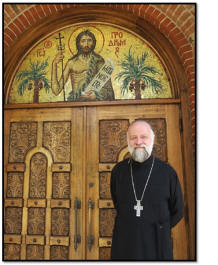 Arkady
Shevchenko, former Deputy Secretary General of the United Nations,
buried here at the expense of the parish, was baptized, married, and
buried by Fr. Victor.
Arkady
Shevchenko, former Deputy Secretary General of the United Nations,
buried here at the expense of the parish, was baptized, married, and
buried by Fr. Victor.
The parish plans to erect a monument and bell in memory of the
victims of communism next to the late Soviet dissident Mikhail
Makarenko, who organized the first unofficial avant-garde art
exhibit in the USSR.
The Russian section of the cemetery includes the grave of the
renowned monarchist and journalist Yuri Meyer. His daughter, Natalia
Clarkson, was Fr. Victor’s superior at VOA. The Russian Department
there had some 120 employees.
The cemetery is also home to the remains of Tamara Stebletz and Olga
Rabchevsky. Elena Yakobson, a parishioner, was a professor at George
Washington University. Her voice was the first to be heard on the
VOA broadcasts to the USSR. Givi Kobi, renowned among the Orthodox
Christians of Washington for his generosity, former head of the
Georgian Department of the VOA, lies here, too, with his wife Maria.
Elena Fortunatova-Cox, Editor-in-Chief of one of the first glossy
magazines in the USSR, America, is here, too. Better known as
Lyalya, she was for a long time the choir director and secretary of
the parish council, and baked prosphoras. Her husband, Leonid Cox,
learned Russian and Church Slavonic, and read in church with an
expressive, southern accent.
"The kind souls of the founders of our parish’s benevolent fund,
which is active to this day, served as remarkable examples of the
Christian life," said Fr. Victor. "Our cemetery is home to many good
Russians who in the 1950s pooled their pennies, buying individual
bricks to build our wonderful church."
***
"Long before the events of 1991, I always told Russians that the
time will come when my broadcasts will end, because they will no
longer be needed, because such programs will be produced in Russia
itself, and they will be much better," continued Fr. Victor. "I
worked at VOA for thirty years, and I feel that I played a role in
the events of 1991. VOA is not the same today: once one of the most
renowned news sources in the world, it is now an informational
website. Our parish has grown since then anyway, and I could no
longer continue to occupy myself both with journalism and being
parish rector. Over 36 years in Washington, DC, I have met with many
remarkable people, thousands of hours on the air and the joy of
communicating with my listeners in the Soviet Union and Russia. I
fulfilled my role as a journalist and I am eternally thankful to the
Lord for the opportunity to partake in the religious rebirth of my
fervently-beloved historic homeland."
Tatiana Veselkina


